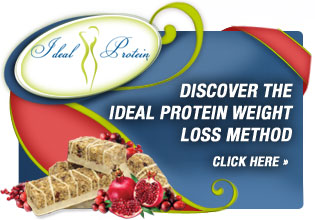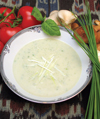What we eat on the Ideal Protein Diet
|
What's
on the Ideal Protein Diet? |
| |
In
addition to the seafood, meat, vegetables and salad that you’ll provide,
you will enjoy the Ideal Protein line of instant protein packets. Here’s
a sampling of what’s currently available. (More products are being
added all the time!) The
protein packets are quick and easy -- just add water and shake! (Some
require heating or refrigeration.) |
Enjoy
these scrumptious Ideal Protein foods: |
|
• Omelets, Pancakes, Muffins and
Oatmeal
• Puddings, Gelatin, Yogurt
• Cold fruit-flavored drinks
|
•
Hot drinks – Chocolate and Cappuccino
• Chili and Spaghetti
• Protein Bars and Snacks |
LOGO HERE
|
| Each
packet contains one serving. On average, each serving consists of 18 grams
of protein and 2 grams of carbohydrate. Sweeteners include sucralose and
acesulfame-potassium (“Ace-K”). |
|
The Protein Blends
used in each product may consist of combinations of milk protein concentrate,
whey protein concentrate, lactoserum protein isolate, calcium caseinate,
soy protein isolate, albumin (egg white protein), and hydrolyzed collagen.
All products are vegetarian
– even the “chicken” soup and the “meaty”
chili!
|
The
Four Phases of the Ideal Protein Diet |
| The Ideal
Protein Diet consists of 4 phases. Phase 1 is the primary weight loss phase.
You will stay on Phase 1 until you have lost about 80% of the weight you
wish to lose. Phases 2, 3, and 4 are designed to gently bring your body
back to regular, nutritionally-balanced eating without the Ideal Protein
packets and supplements.
|
| During
Phase 1, you’ll have 3 Ideal Protein packets per day. Some folks with
special dietary needs may be advised to have a 4th packet each day during
an initial period.
In addition to the protein packets, you’ll need
to eat plenty of vegetables and lettuce greens along with some lean meats,
poultry, and seafood. Plan to drink lots of water, use sea salt, and add
some olive oil to your diet on a daily basis.
Important Note: There is a “personalized”
version of the Ideal Protein Diet tailored to the special needs of those
who are under Doctor’s care for specific medical conditions such
as diabetes, hypertension, immune disorders, and obesity.
Following is the suggested meal plan for Phase 1.
|
| |
|
Suggested
Ideal Protein Packets |
| Breakfast |
1
Serving of Ideal Protein + Coffee or Tea |
Omelet,
Pancake, Muffin, Oatmeal * |
| Lunch |
1
Serving of Ideal Protein + 2 cups Vegetables + unlimited lettuce greens
|
Soup,
Chili, Spaghetti*,
Hot Drink, Cold Drink |
| Dinner |
200g
of Lean Seafood or 150g of Lean Meat
+ 2 cups Vegetables + unlimited lettuce greens
|
|
| Snack |
1
Serving of Ideal Protein
(2 Servings for some who may need more.)
|
Pudding,
Gelatin, Protein Bar, Soy Nuts, Yogurt, Hot Chocolate, Cappuccino, Fruit-Flavored
Drink * |
| Other |
Salt
+ Water (minimum 2 quarts or 2 liters)
+ 1 to 2 teaspoons olive oil. Vitamin/Mineral Supplements |
|
| *
Some of the Ideal Protein packets have a few more calories and carbohydrates
than others. You are restricted to “one per day” of the following
packets: Protein bar, Pancake, Oatmeal, Soy Nuts, Chili, and Muffin. For
the Spaghetti, you are further restricted to not more that 1 packet every
2 days. (These restrictions apply to Phases 1 and 2 only – not to
Phases 3 and 4.) |
|
Lean
Meats
- Beef:
Tenderloin, rib eye, flank steak, rump steak, roast beef, filet mignon
or tournedos, extra-lean ground beef, shank.
- Pork:
Pork tenderloin, fat-free cooked ham.
- Veal:
Cutlet, tenderloin, shank, inside round steak, breast, shoulder, rib.
-
Poultry: (skinless) chicken, guinea fowl, turkey.
-
Other: Deer, moose, rabbit, ostrich meat, frog’s legs, heart,
liver, sweetbreads, kidneys.
Lean Seafood
- Fish:
Bass, haddock, anchovy, catfish, pike, walleye, smelt, swordfish, halibut,
gudgeon, monk fish, sea bass, whiting, hake, cod, perch, skate, shark,
cat shark, Atlantic John Dory, sand pickerel, redfish, sole, tuna (except
red tuna); trout, turbot, red snapper.
-
Seafood: Squid, crab, shrimp, lobster, oysters, crawfish, scampi, mussels,
clams, and scallops (4 large).
Vegetables
Asparagus, Swiss chard, broccoli, celery,
celeriac, mushrooms, cauliflower, Chinese cabbage (pakchoi, bok choy),
kale, curly kale, red cabbage, sauerkraut, cucumbers, dill pickles, zucchini,
endive, fiddleheads, algae, watercress, spinach, fennel, soybean sprouts,
all types of lettuce, alfalfa, field greens, turnip, green onions, raw
onions, hot peppers, sorrel, leeks, cooked red bell peppers, cooked green
bell peppers, radicchio, radish.
Vegetables limited to twice per week (because
of higher carbohydrate counts)
Eggplant, Brussels sprouts, palm hearts,
wax beans, green beans, snow peas, and tomatoes. (Note: These restrictions
apply to Phases 1 and 2 only – not to Phases 3 and 4.)
Seasonings
Garlic, lemon, spices, fines herbs, ginger,
hot mustard, hot sauce, soy sauce, Tamari sauce, white vinegar, apple
cider vinegar.
Essential Vitamins
and Minerals
- Multi-Vitamin
(1 per day with food)
-
Calcium-Magnesium tablets (4 per day; 2 at dinner + 2 at bedtime)
-
Potassium-Calcium tablets (1 per day)
-
Sodium: Add the equivalent of one teaspoon of salt per day to your lunch
and supper. Sea Salt is highly recommended.
-
Additional vitamins and minerals may be suggested to address specific
needs.
|
|
|
|



